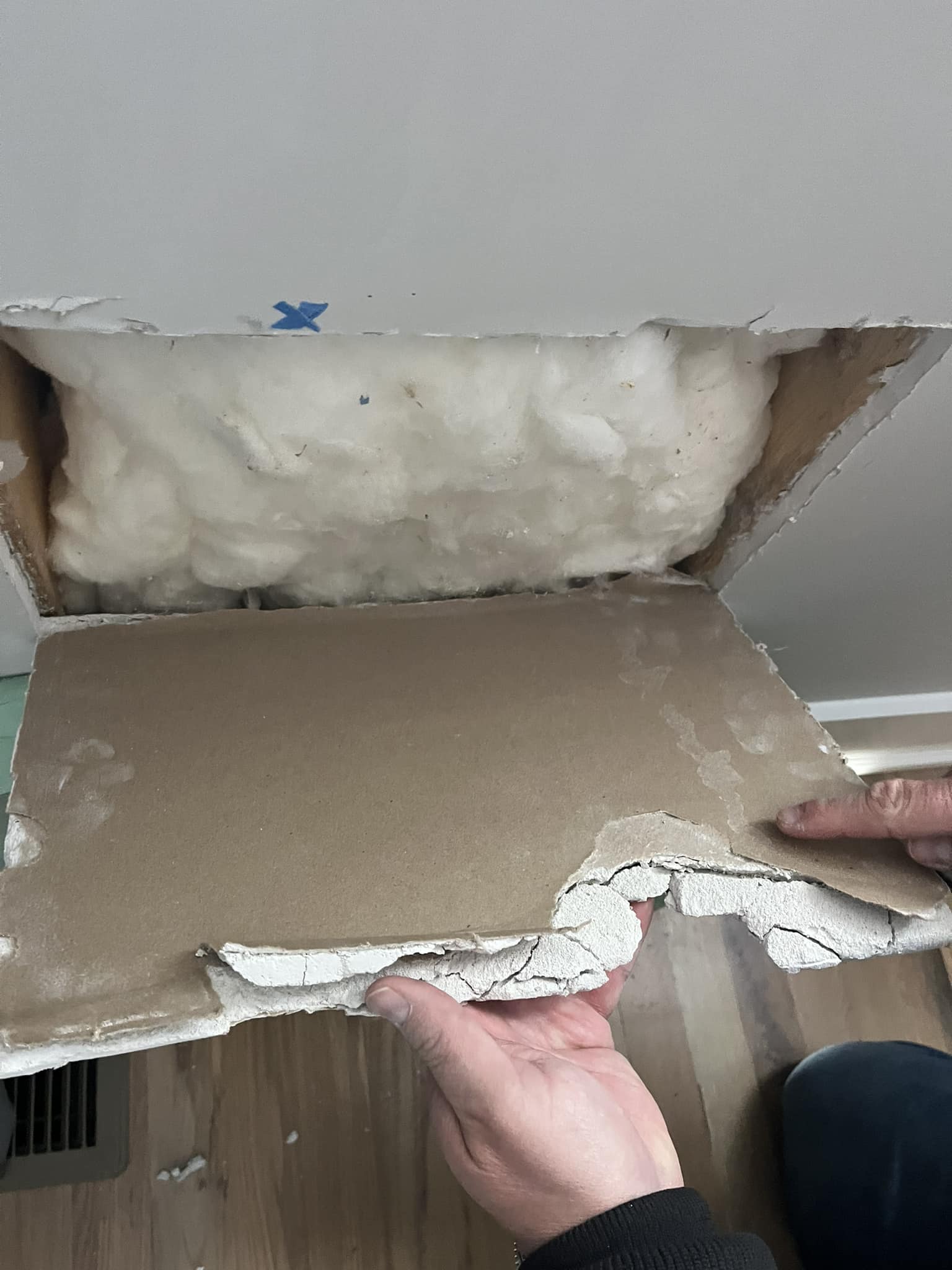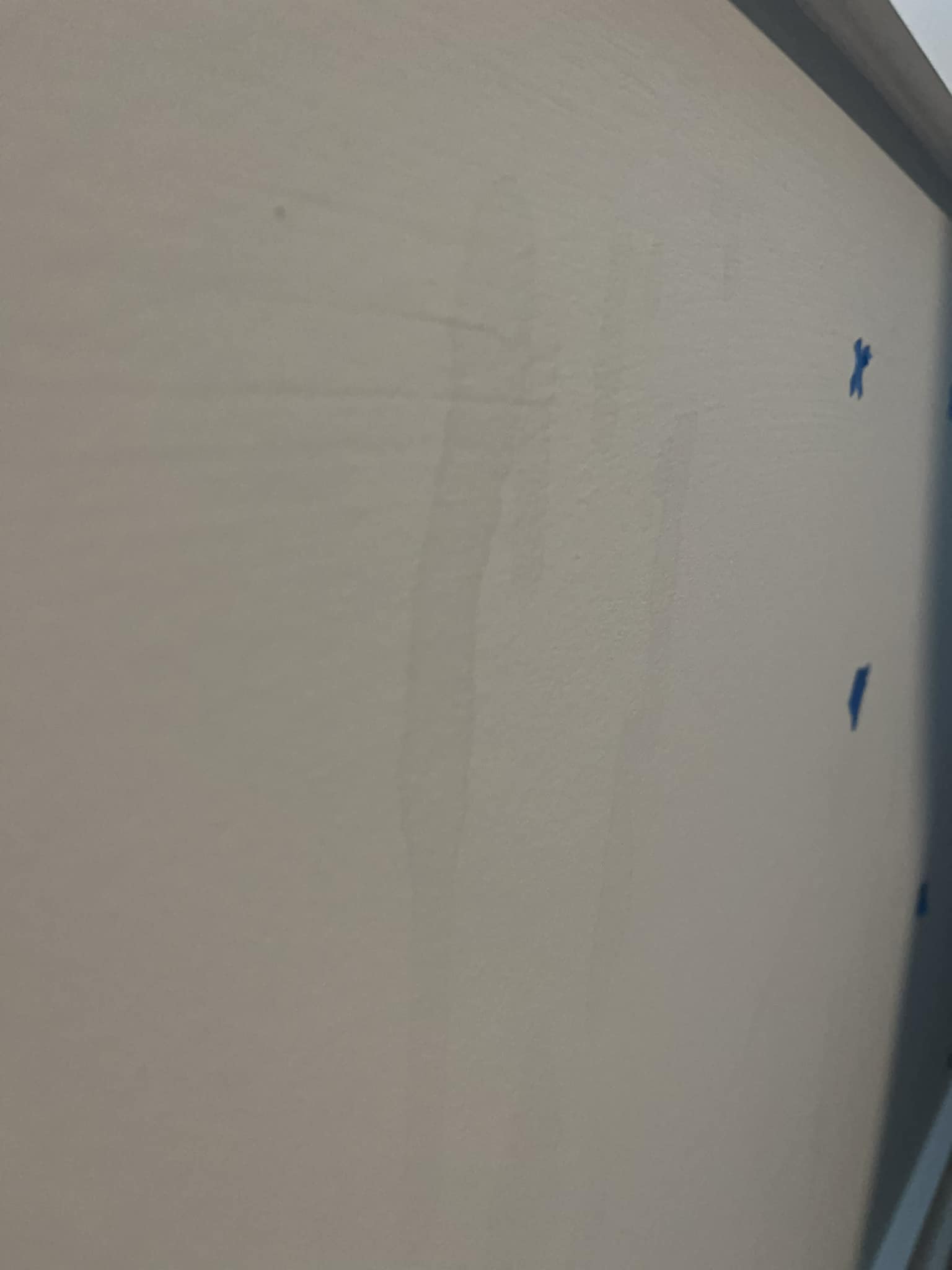Is the white residue on the cut drywall a result of moisture or just random dust, considering the dark moisture marks on the wall paint side and elevated moisture behind the wall before cutting it back?
8 months ago
Last Updated: October 9, 2024
Do those white powdery marks inside the cut drywall look like they’re from moisture, or is it just random dust? We noticed some dark moisture marks on the painted side of the wall, which is why we decided to cut out a piece of drywall. We’re hoping it’s just surface condensation from the high humidity we had last summer, and not something coming from behind. We did find elevated moisture behind the wall before we cut it out.


It’s hard to say for sure, it might be due to sweaty hands during installation. I recommend using a moisture meter to check nearby areas or an Infrared camera.
To me, it appears to be dust. Your insulation seems dry with no moisture.
Mentioned the drip stains on the wall, which is why we decided to cut a piece back.
: Did you cut into your drywall because you noticed slight water marks on the front? Seems a bit extreme, like using a chainsaw instead of a scalpel…
Here’s a tip for next time: Invest in a $20 moisture meter from Lowes or a similar store to check for moisture levels.
: Yep, we found high moisture levels behind that wall, which is why we cut into it to investigate. Also, I’m wondering if those white marks on the other side of the drywall are just dust or signs of water damage inside the wall.
: Is there a solid wall behind there?
Hey , since this is the mainfloor bedroom, I believe it’s just wood with green zip sheathing. There doesn’t seem to be any visible damage or wetness on the trim or window sill. There are supply vents under the window (connected to three side by side windows), but the marks are spread across the wall beneath the long window and not just above the vents.
Hey, I’m assuming (since I can’t physically see it) that what you’re observing might be condensation or a spill on the drywall. The powdery substance on the back is probably a mix of drywall dust, insulation residue, and sweat/spit from the installer. If you have a microscope, you can easily determine if it’s organic.
But make sure to pull down your insulation and inspect for any signs of water infiltration beneath the window.
Mentioned pulling back the white insulation in the picture and finding the wood to be dry. They wonder if it dried out quickly inside or if it appears to be more like condensation and superficial damage.
An anonymous participant pointed out that evidence of water would still be visible even if it had dried, resembling a shadow line.
Wow, there’s complimentary candy hidden in the walls. How cool!
Haha seems like it’s just sheetrock dust to me.
Hey , do you have any ideas about what might be causing those moisture stains on the painted wall?
I don’t notice any moisture stains on the backside, but there seems to be some discoloration on the front that looks more like an oil stain. It’s hard to tell from just the picture, but certain things can definitely stain the paint. For example, my brother shot my mom’s ceiling with a paintball gun, and even after 20 years, that spot still bleeds through when you paint over it.
In this new construction, there are stains all over the house.
If someone spilled some kind of oil-based substance, that might be the cause of the mess. You could try cutting out a piece and painting over it with latex to see if it bleeds through, then test with oil-based paint.
If there was no moisture, you’d notice it on the insulation with distinct water drop patterns.
What do you reckon led to all the moisture stains on the wall?
Well, on the bright side, you’re honing your drywall skills! That’s a neat patch right there!
The builder will take care of patching, not me haha
I thought this was a DIY page, not a place to ask questions just to show off your knowledge over the builder.
Asked some real questions because we’re trying to get to the bottom of the water stains and wanted to double-check if the marks on the drywall are from dust or water. I’m not skilled at fixing drywall, so I mentioned that the builder will handle it. Where did I imply that I know more than the builder? Nobody has been able to identify the water marks on the wall, so I turned to this platform for some advice.
An anonymous participant agreed that they weren’t sure where it originated from, acknowledging that’s the essence of this discussion. Let’s continue.
This is quite interesting. How did you go about testing for moisture before cutting the drywall? I have a couple of questions that might help narrow this down since water could be coming from other areas before reaching where you’ve noticed it.
Do you happen to have a moisture meter? If you do, does it show higher readings when the AC is running? What about after a rainstorm? Using a moisture meter, have you looked into the area above and around to see the extent of moisture spread?
What is located above this particular wall? Is there a bathroom on the upper floor nearby? If this is an upper-level wall, is your HVAC system in the attic? Have you inspected that area for any signs of moisture?
Is there any plumbing within this wall, nearby, or above it?
Mentioned that there was a moisture meter used and it showed elevated levels at one point. They are not certain if it rained recently. Despite having a large window above, the trim and window sill appear to be dry. The elevated moisture levels were recorded during summer with the AC on, but now they have the heat running. This area is on the main floor, directly above is an unfinished attic space with blown-in insulation. Although the streaks are present throughout the house, this particular wall seems to be in worse condition compared to others.
Hey, my AC struggles to cope with the heat during the hottest part of the year. The unit might be too small. It gets humid in the house for about a month. You may want to have the R22 refrigerant level checked. If your unit had trouble cooling the place when it was new, it could be due to its size (like in my case).
The new HVAC system seems to be cooling fine.
Hey there! It seems like you might need to troubleshoot this situation a bit. Do you still have the moisture meter? If so, I suggest checking the levels in different parts of your house at various times. You could create a table listing the rooms, walls, and their moisture levels as a baseline for dry weather. Then, monitor them during rainy days to see if the moisture increases. Keep track of the numbers and try again with the AC On in the spring or summer. It could be related to the AC, but it’s tricky to determine.
Got a new house in the summer and found water stains on several walls, not just one. Could it be because of the high humidity causing surfactant leaching?
I can’t spot a vapor barrier anywhere. If you end up cutting and removing it, make sure to tape it back on securely.
Do you mean that there is usually no vapor barrier between the wall and the insulation?
Sure thing! Yes, any exterior wall should have a vapor barrier installed on the studs after the insulation. The same goes for ceilings on the top floor or ranch-style homes.
I heard from an anonymous participant that if it’s spray foamed, there’s no need for a vapor barrier.
Hey , so there’s plywood underneath that insulation and the outer wall has this green zip sheathing material.
I wouldn’t be too concerned about that on its own.
Appears to be standard
Seems to be surfactant leaching. It appears to not be related to moisture behind the drywall.
https://www.benjaminmoore.com/en-us/contractors/job-solutions/troubleshooting/surfactant-leaching